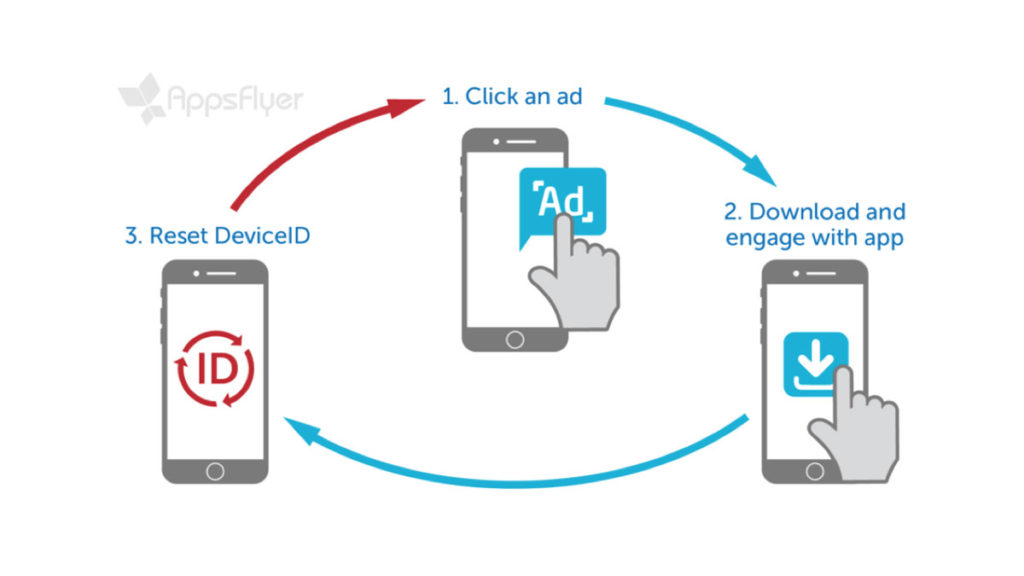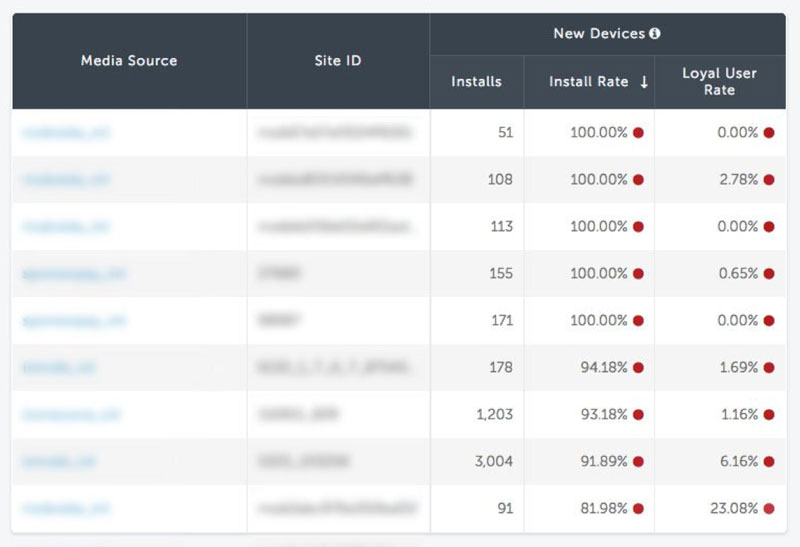 Identifying mobile fraud in the mobile ecosystem can be a challenge for advertisers and Agencies alike. We are seeing increasingly more new fraud methods designed to exploit the system, such as Install Fraud and Click Fraud.
Identifying mobile fraud in the mobile ecosystem can be a challenge for advertisers and Agencies alike. We are seeing increasingly more new fraud methods designed to exploit the system, such as Install Fraud and Click Fraud.
DeviceID Reset Fraud has recently been launched by mobile attribution and marketing analytics platform AppsFlyer to give the advertiser the ability to identify and block fraud based on device ID indicators. But is fraud detection mainly a problem for advertisers? Or is it an industry-wide problem that, more importantly, should also have established standards?
In this article, we will showcase the different approaches to identifying device ID fraud, including a case study. Until now there has been no Internet Advertising Bureau for installing apps, and instead a fraud taskforce comprised of an independent group of experts has been setting the standards. However, there is always room for improvement. If you want to learn how we see the industry combatting fraud in the future, please read on.
Case Study: Device ID fraud
Pocket Media is a mobile media agency that represents advertisers and publishers. Agencies like us must ensure that we provide clear parameters for the different types of fraud, whether click fraud, injection fraud or device fraud. Since advertisers use attribution platforms, it is important to be fully aligned. Many agencies have their own fraud systems or use third-party lookup systems.
Pocket Media was recently introduced by an advertiser to the new AppsFlyer device ID metrics. To help the advertiser and understand these new metrics, we spoke to AppsFlyer about this new fraud metric.
What is Device ID Fraud?
Device ID fraud or DeviceID Reset Fraud is a type of click, install and engagement fraud where criminals click on real ads, install the actual apps, and engage with them for a long period. Using massive install farms, fraudsters reset their device IDs between each install, effectively generating significant numbers of “real” clicks, installs and retention from new device IDs, bypassing real-time anti-fraud protection measures.

A recent study found that DeviceID Reset Fraud now accounts for over 50% of all mobile install fraud. AppsFlyer claims to have all devices in their global system, so when a new device doesn’t fit, it can be identified by the advertiser as fraudulent. However, AppsFlyer advises that device ID fraud is only one indicator that should always be viewed in conjunction with other fraud metrics.

Device ID Fraud Metrics
We were curious to know if our other partners also include this fraud indicator in their approach to combatting fraud. The biggest problem with device data is the lack of available data, as well as privacy concerns that don’t allow us to track all the device identifiers that are physically there.
Our mobile marketing partner Tune doesn’t include the device data in their metrics to combat fraud. Rather, they see their role as an educator for advertisers, networks and agencies. Through their Tune Partner Centre, they aim to offer the necessary support and guidance but stress the need for more collaboration between networks, advertisers, agencies and publishers. For Tune, data and transparency is key. On the subject of device data, they ask themselves questions like: is it possible to keep up with all the new phones that are entering the market on a daily basis?
 Mobile attribution and analytics leader Kochava developed their Fraud Console and Global Fraud Blacklist to detect and prevent mobile ad fraud. The Fraud Console detects and visualises over 14 types of fraud across a marketer’s apps, and the Global Fraud Blacklist tracks definitive fraud across all Kochava traffic and prevents attribution to known bad sources. These tools ensure that a marketer’s ad spend is used on acquiring valid users via legitimate traffic.
Mobile attribution and analytics leader Kochava developed their Fraud Console and Global Fraud Blacklist to detect and prevent mobile ad fraud. The Fraud Console detects and visualises over 14 types of fraud across a marketer’s apps, and the Global Fraud Blacklist tracks definitive fraud across all Kochava traffic and prevents attribution to known bad sources. These tools ensure that a marketer’s ad spend is used on acquiring valid users via legitimate traffic.
In addition, device data is included in the High Click Volumes and Multi-Hash Attribution visualisations in the Fraud Console. They are also currently looking for instances at the sub-publisher level, where there is an inordinately high percentage of new devices or when there are obvious forms of manufactured (non-legitimate) installs.
Lastly, mobile measurement company Adjust makes a decision on every install that comes in, as explained in their Fraud Prevention Suite.
Pocket Media Pushing for Blockchain Technology to Combat Fraud
As the CEO of Pocket Media and with over 10 years’ experience in mobile, I am heavily involved with the latest developments in technology and sales channels. So when it comes to the theme of fraud, I’d like to share these personal insights:
For us, it’s important to gather all perspectives on new fraud topics to be able to advise our partners who are dealing with these issues. At the same time, we believe there should be more collaboration and transparency between all parties in the ecosystem. We need to set standards and try not to win customers just because one platform has a different way of identifying fraud.
 I see opportunities for the future where blockchain technology can help make the industry more transparent, whereby all fraudulent behaviour can be validated by blockchain. Why would there not be a blockchain where every install is being validated through independent sources? To do so, fraud prevention companies must combine all the data from attribution platforms and agencies and provide yes/no validation on the install. If it’s a no, that data can be shared.
I see opportunities for the future where blockchain technology can help make the industry more transparent, whereby all fraudulent behaviour can be validated by blockchain. Why would there not be a blockchain where every install is being validated through independent sources? To do so, fraud prevention companies must combine all the data from attribution platforms and agencies and provide yes/no validation on the install. If it’s a no, that data can be shared.
Currently, if advertiser A is receiving potential fraud using AppsFlyer as an attribution platform, then advertiser B is likely receiving the same traffic using, for instance, Tune’s attribution platform. AppsFlyer may identify this as fraud while Tune doesn’t. For the agency, the result is unclear even though the traffic is continuing to run via them. If this could be validated via blockchain, we not only share data to kill it but also establish an industry standard. How awesome would that be? However, I believe it will take time to get there.
Conclusion
The device ID metrics case study shows that every party is combatting fraud on its own terms without collaborating with other parties. There is no industry standard, not enough transparency and a lack of collaboration. Blockchain may be the glue that will unify the industry and make it more transparent.
Article by Benjamin Pomerantz, CEO at Pocket Media
 About Benjamin:
About Benjamin:
Benjamin Pomerantz is the founder of Pocket Media (2012). He is a natural digital entrepreneur with wide experience in mobile performance advertising.
Pocket Media is a Dutch based Mobile Media Agency specializing in mobile display and video advertising. Currently Pocket Media operates worldwide in more than 180 countries and has offices in Amsterdam, New York, Singapore and Tel Aviv.
Source: Pocket Media

You must be logged in to post a comment Login